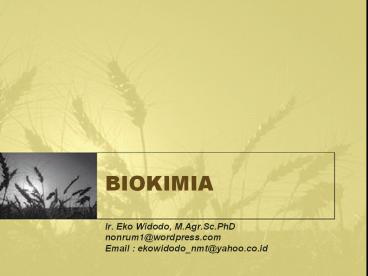BIOKIMIA - PowerPoint PPT Presentation
Title:
BIOKIMIA
Description:
Ir. Eko Widodo, M.Agr.Sc.PhD nonrum1_at_wordpress.com Email : ekowidodo_nmt_at_yahoo.co.id Buku Acuan Trudy McKee and James McKee. 2003. Biochemistry: The Molecular Basis ... – PowerPoint PPT presentation
Number of Views:1771
Avg rating:3.0/5.0
Title: BIOKIMIA
1
BIOKIMIA
- Ir. Eko Widodo, M.Agr.Sc.PhD
- nonrum1_at_wordpress.com
- Email ekowidodo_nmt_at_yahoo.co.id
2
Buku Acuan
- Trudy McKee and James McKee. 2003. Biochemistry
The Molecular Basis of Life. Third edition.
McGraw-Hill, Boston. - Lehninger, Nelson, Cox. 1997. Principles of
Biochemistry.2nd edition. Worth Publishers. - Albert L. Lehninger. 1995. Dasar-dasar Biokimia.
(Alih bahasa Maggy Thenawidjaja). Penerbit
Erlangga, Jakarta. - David S. Page. 1995. Prinsip-prinsip Biokimia.
Penerbit Unair, Surabaya. - Soeharsono. 1982. Biokimia I dan II. Gadjah Mada
University Press, Yogyakarta.
3
Tata Tertib Kuliah
- Tepat waktu, toleransi maks. 15 menit
- Tidak Berisik
- HP tidak diaktifkan
- Hadir minimal 70
- Paham bahasa Indonesia Inggris
- Baca salah satu / dua buku acuan
- Kerjakan Tugas, Mid, Ujian
4
Tujuan Perkuliahan
- Mengenalkan dan memahamkan bahasa biokimia
Kosakata (istilah dan struktur kimia), tatabahasa
(reaksi-reaksi kimia), struktur kalimat (Jalur
metabolisme) dan arti (keterkaitan metabolik)
5
What is biochemistry?
- Definition
- Websters dictionary Bios Greek, meaning
life The chemistry of living organisms the
chemistry of the processes incidental to, and
characteristic of, life. - WebNet dictionary Biochemistry is the organic
chemistry of compounds and processes occuring in
organisms the effort to understand biology
within the context of chemistry.
6
What is biochemistry?
- Understanding biological forms and functions in
chemical terms - Biochemistry aims to understand how the lifeless
molecules interact to make the complexity and
efficiency of the life phenomena and to explain
the diverse forms of life in unifying chemical
terms.
7
Issues addressed by biochemistry
- What are the chemical and three-deminsional
structure of biomolecules? - How do biomolecules interact with each other?
- How does the cell synthesize and degrade
biomolecules? - How is energy conserved and used by the cell?
- What are the mechanisms for organizing
biomolecules and coordinating their activities? - How is genetic information stored, transmitted,
and expressed?
8
History of Biochemistry
- First to reveal the chemical composition of
living organisms.
The biologically most abundant elements are only
minor constituents of the earths crust (which
contains 47 O, 28 Si, 7.9 Al, 4.5 Fe, and
3.5 Ca).
The six principle elements for life are C, H,
N, O, P, and S.
99 of a cell is made of H, O, N, and C 99 of a cell is made of H, O, N, and C 99 of a cell is made of H, O, N, and C
Element unpaired es Fractional amount
H 1 2/3
O 2 1/4
N 3 1/70
C 4 1/10
9
Most of the elements in living matter have
relatively low atomic numbers H, O, N and C are
the lightest elements capable of forming one,
two, three and four bonds, respectively.
The lightest elements form the strongest bonds
in general.
10
History of Biochemistry
- Then to identify the types of molecules found in
living organisms.
- Amino Acids
- Nucleotides
- Carbohydrates
- Lipids
11
History of Biochemistry
- Then to understand how the biomolecules make life
to be life.
12
Relationship between Biochemistry and other
subjects
- Organic chemistry, which describes the properties
of biomolecules. - Biophysics, which applies the techniques of
physics to study the structures of biomolecules. - Medical research, which increasingly seeks to
understand disease states in molecular terms. - Nutrition, which has illuminated metabolism by
describing the dietary requirements for
maintenance of health.
13
Relationship between Biochemistry and other
subjects
- Microbiology, which has shown that single-celled
organisms and viruses are ideally suited for the
elucidation of many metabolic pathways and
regulatory mechanisms. - Physiology, which investigates life processes at
the tissue and organism levels. - Cell biology, which describes the biochemical
division of labor within a cell. - Genetics, which describes mechanisms that give a
particular cell or organism its biochemical
identity.
14
(1) ENERGY, which it must know how to
Life needs 3 things
- Extract
- Transform
- Utilize
15
(2) SIMPLE MOLECULES, which it must know how to
Life needs 3 things
- Convert
- Polymerize
- Degrade
16
(3) CHEMICAL MECHANISMS, to
- Harness energy
- Drive sequential chemical reactions
- Synthesize degrade macromolecules
- Maintain a dynamic steady state
- Self-assemble complex structures
- Replicate accurately efficiently
- Maintain biochemical order vs outside
17
Trick 1 Life uses chemical coupling to drive
otherwise unfavorable reactions
18
Trick 2 Life uses enzymes to speed up
otherwise slow reactions
19
How does an enzyme do it, thermodynamically?
20
How does an enzyme do it, mechanistically?
21
The Versatile Carbon Atom is the Backbone of Life
22
Chemical IsomersInterconversion requires
breaking covalent bonds
23
Stereoisomers Chemically identical
Biologically different!
24
Stereoisomers Chemically identical
Biologically different!
25
Biochemical Transformations Fall into Five Main
Groups
- Group transfer reactions
- Oxidation-reduction reactions
- Rearrangements (isomerizations)
- Cleavage reactions
- Condensation reactions
26
Biomolecules Structure
- Building block
- Simple sugar
- Amino acid
- Nucleotide
- Fatty acid
- Macromolecule
- Polysaccharide
- Protein (peptide)
- RNA or DNA
- Lipid
27
Biosynthesis Requires Simple Molecules to Combine
Covalently in Many Ways
28
1. Relative electronegativities of the two
atoms
Bond strength includes dependence on
High electronegativity High affinity for
electrons
- P 2.1
- H 2.1
- Na 0.9
- K 0.8
- O 3.5
- Cl 3.0
- N 3.0
- C 2.5
29
2. The number of bonding electrons
30
Common Bond Strengths
Approx. Avg.
Triple 820 kJ/mole
Double 610 kJ/mole
Single 350 kJ/mole
31
Common Functional Groups
32
Important Biological NucleophilesElectron-rich
functional groups
33
In summary
- Tetrahedral carbon has versatile bonding
properties - Compounds with many atoms may exist in many
isomeric forms - Interconversion requires breaking chemical
bonds - Large molecules are built from small ones by
making new chemical bonds

